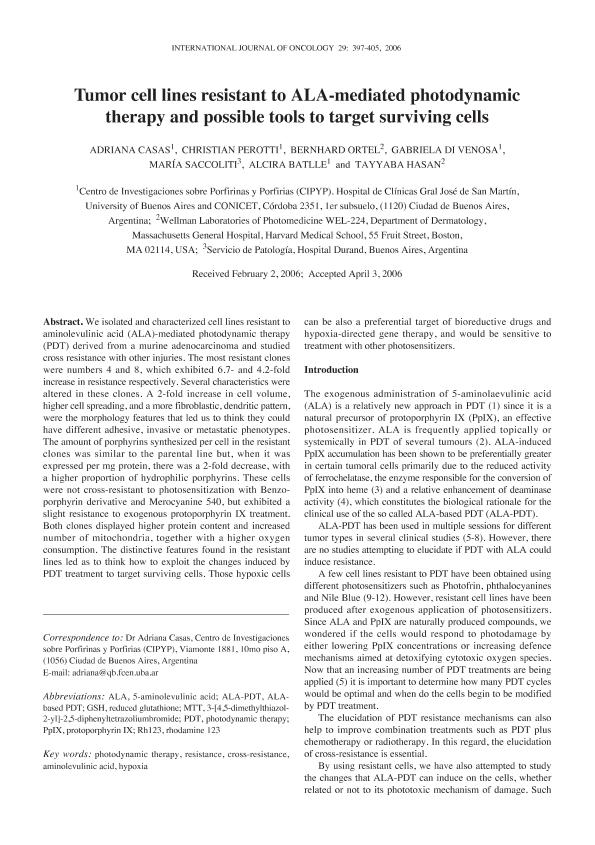Artículo
Tumor cell lines resistant to ALA-mediated photodynamic therapy and possible tools to target surviving cells
Casas, Adriana Gabriela ; Perotti, Christian; Ortel, Bernhard; Di Venosa, Gabriela Mariana
; Perotti, Christian; Ortel, Bernhard; Di Venosa, Gabriela Mariana ; Saccoliti, María; Batlle, Alcira Maria del C.
; Saccoliti, María; Batlle, Alcira Maria del C. ; Hasan, Tayyaba
; Hasan, Tayyaba
 ; Perotti, Christian; Ortel, Bernhard; Di Venosa, Gabriela Mariana
; Perotti, Christian; Ortel, Bernhard; Di Venosa, Gabriela Mariana ; Saccoliti, María; Batlle, Alcira Maria del C.
; Saccoliti, María; Batlle, Alcira Maria del C. ; Hasan, Tayyaba
; Hasan, Tayyaba
Fecha de publicación:
08/2006
Editorial:
Spandidos Publications
Revista:
International Journal of Oncology
ISSN:
1019-6439
Idioma:
Inglés
Tipo de recurso:
Artículo publicado
Clasificación temática:
Resumen
We isolated and characterized cell lines resistant to aminolevulinic acid (ALA)-mediated photodynamic therapy (PDT) derived from a murine adenocarcinoma and studied cross resistance with other injuries. The most resistant clones were numbers 4 and 8, which exhibited 6.7- and 4.2-fold increase in resistance respectively. Several characteristics were altered in these clones. A 2-fold increase in cell volume, higher cell spreading, and a more fibroblastic, dendritic pattern, were the morphology features that led us to think they could have different adhesive, invasive or metastatic phenotypes. The amount of porphyrins synthesized per cell in the resistant clones was similar to the parental line but, when it was expressed per mg protein, there was a 2-fold decrease, with a higher proportion of hydrophilic porphyrins. These cells were not cross-resistant to photosensitization with Benzoporphyrin derivative and Merocyanine 540, but exhibited a slight resistance to exogenous protoporphyrin IX treatment. Both clones displayed higher protein content and increased number of mitochondria, together with a higher oxygen consumption. The distinctive features found in the resistant lines led as to think how to exploit the changes induced by PDT treatment to target surviving cells. Those hypoxic cells can be also a preferential target of bioreductive drugs and hypoxia-directed gene therapy, and would be sensitive to treatment with other photosensitizers.
Palabras clave:
AMINOLEVULINIC ACID
,
CROSS-RESISTANCE
,
HYPOXIA
,
PHOTODYNAMIC THERAPY
,
RESISTANCE
Archivos asociados
Licencia
Identificadores
Colecciones
Articulos(CIPYP)
Articulos de CENTRO DE INVEST. SOBRE PORFIRINAS Y PORFIRIAS
Articulos de CENTRO DE INVEST. SOBRE PORFIRINAS Y PORFIRIAS
Citación
Casas, Adriana Gabriela; Perotti, Christian; Ortel, Bernhard; Di Venosa, Gabriela Mariana; Saccoliti, María; et al.; Tumor cell lines resistant to ALA-mediated photodynamic therapy and possible tools to target surviving cells; Spandidos Publications; International Journal of Oncology; 29; 2; 8-2006; 397-405
Compartir
Altmétricas



